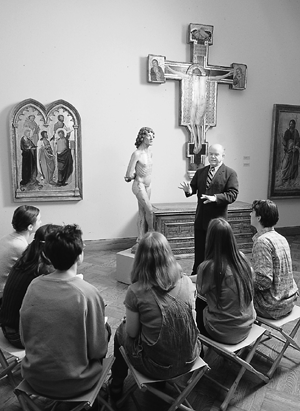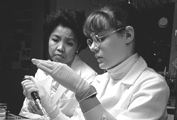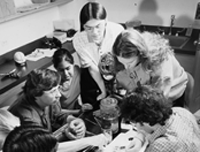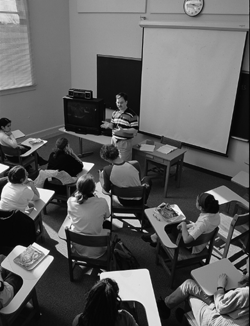A Changing World, A Changing Curriculum

By Kelly Viancourt
Photos by Mike Steinberg
A changing political world. A changing social climate. A changing "toolbox" of teaching methodologies. In its place within the often static realm of higher education, is the Oberlin College curriculum keeping pace with an ever-altering world?
Dean Clayton Koppes says yes, describing the teaching and learning process at Oberlin as a "mix of the traditional and the innovative." As the College continues to emphasize traditional course subjects such as Shakespeare, it remains keenly aware of our dramatic and rapidly changing intellectual world. The impetus for change, therefore, can come from anywhere: global and national trends, student interests, faculty expertise. And the methods of imparting this new knowledge? They had better be evolving as well.
Societal Impacts
"Oberlin had a course on the History of the American Negro in the mid-'50s-one of the first such courses anywhere," Koppes said. "That, in a very circuitous way, has evolved into African-American Studies, which is now an entire discipline. It's a good example of how our curriculum adapts in response to political and social development and larger societal trends."
Emerging from today's global events, for example, are dramatic new opportunities for study of Eastern Europe and the former Soviet Union that affect a range of disciplines.
"The whole study of Russia and Eastern Europe got a boost in the late '40s and '50s because of concern about the Cold War," Koppes said. "The federal government poured lots of money into colleges and universities basically to study what was perceived to be 'the enemy.' The climate today provides us with the chance to learn about Russia in ways that were simply not possible before."

But this, he said, can represent a kind of intellectual trauma for some professors like Heather Hogan, a teacher of Russian history, who found her field re-defined with the breakup of the Soviet Union. She continues to teach a course of 20th century Russian and Soviet history, but with an added emphasis on the 18th century and the history of Russian women.
Beyond the historical and political implications lies the social consequences of the fall of the Wall. The rethinking of Marxism, said sociology professor Bill Norris, led many Marxists to scratch their heads and wonder where history was headed. "We hired a faculty member in sociology who teaches Russian and Eastern European Studies. He's been working on the question of what happens when two multi-national states, the Soviet Union and Yugoslavia, break up. Why is it that one of them collapsed into civil war and the other, led by Russia, seemed to quietly acquiesce?"
As the impact of political milestones makes its way into college classrooms, so do changes in the nature of a discipline itself. David Benzing, the Robert S. Danforth Professor of Biology, said that science itself has changed. "We have seen a major revolution in how science is done and how prominent it is in society, increasingly so, as we grapple with broader, deeper problems." The outcome for Oberlin is revealed in its course catalogue, which outlines more classes in neuroscience, computer science, and biochemistry.

Student Ambitions
New generations of college students bring to campus new generations of interests-another catalyst for curriculum change. "Consider, for example, environmental studies," said Koppes. "We just authorized a new faculty position in environmental studies to deal with the explosive growth of interest in the subject. Jewish history is another."
Student demand affected the languages, leading to courses in Chinese and Japanese and an expansion of Spanish offerings. Interest in other languages is declining.
Also considered are students' future career plans. Particularly in the sciences, acceptance to the top graduate or medical schools is based in part on the strength of an undergraduate experience. The mission of the science curriculum at Oberlin, said Benzing, has always been the same: the training of pre-professionals for academic or professional careers.
Depending upon the year, anywhere from 5 to 10 percent of students from each graduating class apply to medical school. "The acceptance rate is somewhat lower than it used to be, yet it reflects the national average," he said. "A large proportion of our majors in the natural sciences and mathematics continue to enter PhD programs. Oberlin remains a leading source of students bound for doctoral degrees, although we have more competition now than we've had in the past."
A second, broader goal of the science curriculum is to impart science literacy to the other 75 percent of Oberlin students who have no intention of working in the discipline. "Science literacy is more important now than ever because of all the decisions we have to make as responsible citizens; all of the complex issues that have scientific components," Benzing said. "So that's our challenge. And as people charged with imparting science literacy, how do we improve our effectiveness?"
The answer, he said, is to find ways of grabbing these students through subjects that are more immediate and of greater interest to them, then building science into that experience. "Today, for example, we offer 33 courses designed primarily for non-science majors-specially-designed courses that change yearly. One, not surprisingly, is fully appropriate for Oberlin, and that is musical acoustics, taught in the physics department and taken by many Conservatory students.
"We also have a number of courses related to the environment, a course on chemistry and criminal investigations, and a course on climate change that considers this global challenge from the perspectives of the political scientist, anthropologist, ecologist, and earth scientist. So some of these topics cross a number of disciplines, bringing things together, as we must do today, to deal with multi-dimensional problems."
Interdisciplinary study, while not unique to the sciences, is a prominent facet of an Oberlin education. The visual-art major, for example, encourages students to study art in the context of another discipline such as psychology, sociology, philosophy, or architectural design. International studies majors take courses in history, religion, and foreign languages, while the African American studies major emphasizes education, politics, and fine arts.

Active Learning
As the make-up of Oberlin's curriculum changes and adapts, so must the process of instruction. Koppes considers this new methodology as an integration of the intellectual and experiential.
"The buzzword used today is 'active learning,' and it has a lot of applicability," he said. "We find that the more students can be involved in actively participating in discovery and the intellectual process, rather than simply absorbing it from the professor, the richer the experience they take away."
An active learning environment emphasizes discussion and interpretation by students working with each other. "The professor is less the knowledge provider and more a guide in that discussion process," Koppes said. "Not to say that the content is unimportant or the professor passive-here the professor is more dynamic and involved in helping students acquire skills to be active participants in learning."
Acquiring learning skills is the key. Doing so sooner than later is even better. Suzanne Gay, associate dean of the College and associate professor of East Asian studies, said a goal for Oberlin this year was to create more colloquia; small-class experiences for first-year students. The format and content of the courses are flexible; the emphasis is placed on writing, teaching, quantitative reasoning analysis, and research methods.
"The idea here is to learn these academic skills as early as possible because they will serve students well throughout their college years-we don't think of them as extra requirements," Gay said.
English, for example, Oberlin's largest department and most popular major, turned all of its introductory-level courses into colloquia exclusively for first-year students. "We felt that our intro courses were simply too big to make sure every student got the attention he or she needed," said David Walker, professor and chair of the English department. "In keeping with the strong push toward focusing on the first-year experience, we can offer small, intensive classes that focus on analysis, discussion, and attention to writing."
With an enrollment limited to 16 students, each class has a more topical, narrow focus than traditional courses, with titles such as Fictions of Female Development, Place and American Culture, and Poetry, Place and Landscape.
"These courses are taught largely by discussion and will really help prepare students for the kind of analysis, critical thinking, and writing skills they need to go on to courses at more advanced levels," Walker said.
In the sciences, Benzing said, "active learning" translates into "discovery-based learning," meaning that long lectures and cookbook laboratory procedures are replaced with one-on-one research experiences in sophisticated facilities.
"In the old days once you got to graduate school you got into the business of inquiry," he explained. "You learned how to use tools, how to synthesize. You became a scholar, an innovator. Now that process occurs much earlier, certainly well into the undergraduate curriculum. All of our courses, including the introductory courses, are increasingly designed to promote this discovery aspect. Classes are smaller now, especially in the laboratory. They're equipped with instrumentation and the modern tools of science, an inventory that runs into many millions of dollars. This instruction is exceedingly expensive and often requires individual mentorship with faculty."
Although much more labor intensive and a source of considerable stress, a discovery-based undergraduate experience is practically required for students to be accepted at competitive medical or graduate schools, Benzing said. "Active learning is an increase of labor, but is far worth it in the end. This trend will also further distance colleges from universities. Given a university's large student/faculty ratio and emphasis on graduate students, this kind of experience simply cannot be delivered to more than the occasional undergraduate."
Electronic Initiatives
Electronic interaction, as one might expect, also has its place in the Oberlin classroom, but faculty are quick to assert that the Internet is not replacing face-to-face communication. "In many cases, classes have electronic bulletin boards or forums where students and faculty can exchange thoughts before they actually meet in class for discussion," Koppes said. "This is not only more efficient, but helps bring out people's ideas in a more articulated fashion, especially with students who feel shy in a discussion setting."
The topic of technology and pedagogy has struck the interest of several English faculty members, said Walker, yet no one is arguing that the majority of teaching should happen on-line. "I do most of my teaching by discussion. I think that getting students to be as accurate as possible and to ask the questions that are on their minds has everything to do with encouraging them to be independent thinkers. It's what Oberlin has always stood for. The kind of interaction we get in a lively classroom discussion is invaluable. I can't imagine that technology will replace that-at least on this campus."
Regardless of the debate, the issues of how we teach and why are ongoing reflections of the forms of teaching that are best for a new generation of students.
"The lecture mode isn't best for everyone," said Koppes. "It's important to adapt, or maybe subtly shift, our focus. The question is not merely how and what to teach, but more an awareness that we all learn in different ways."